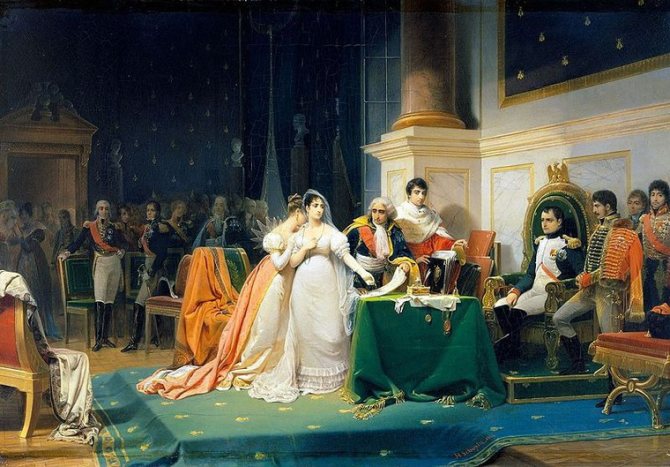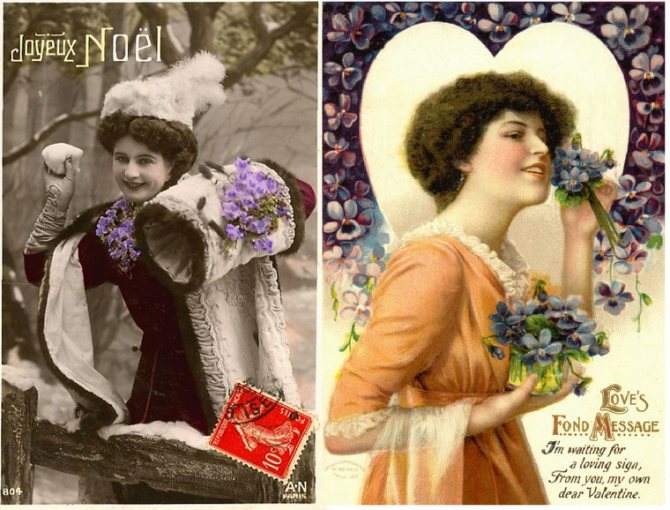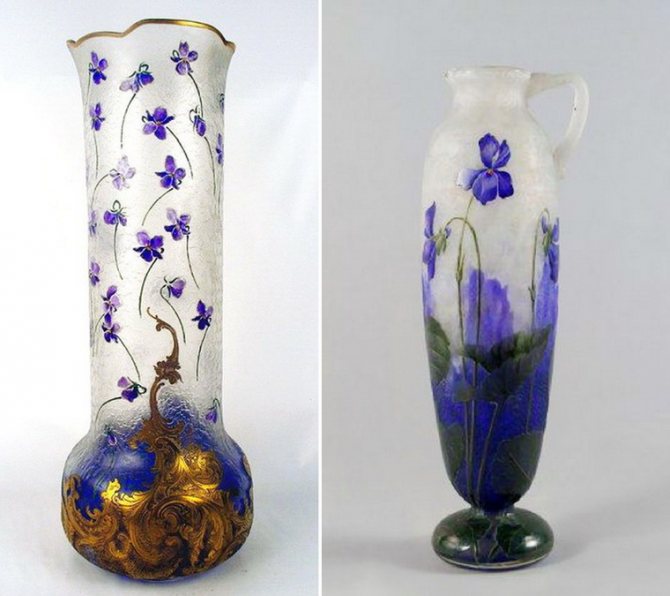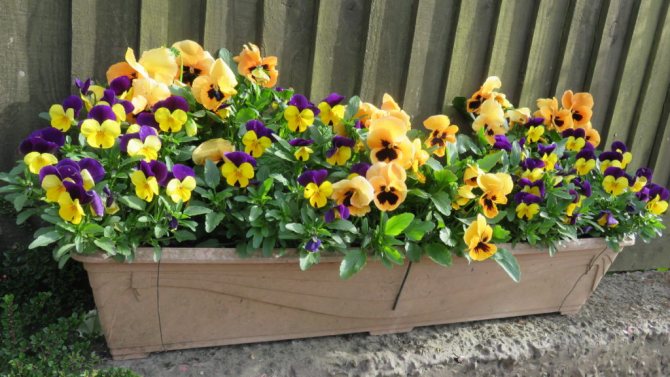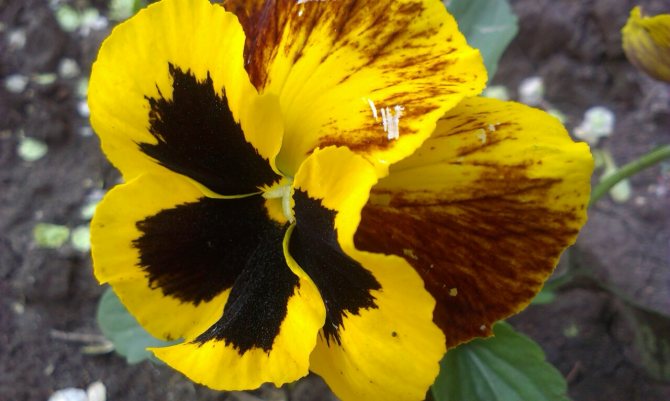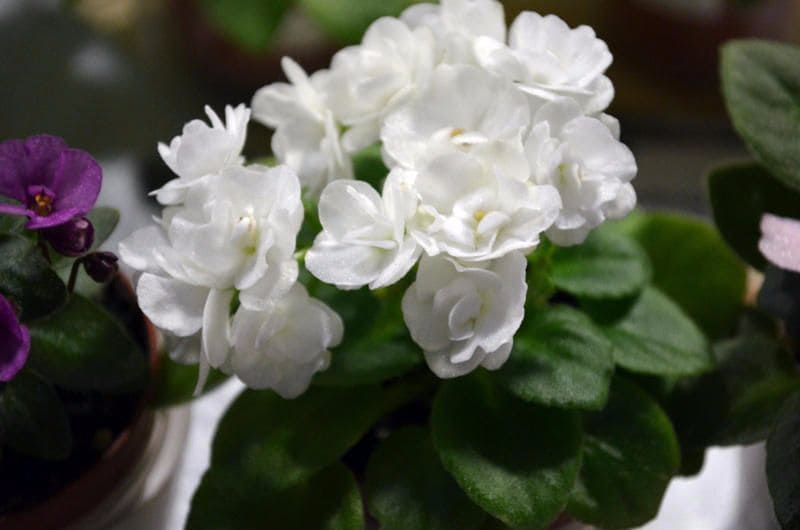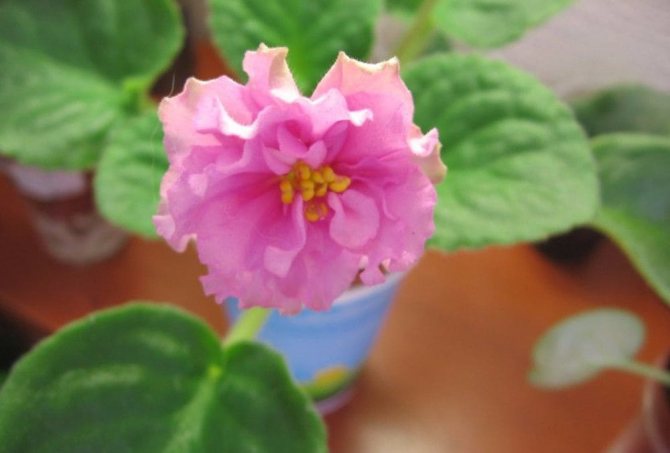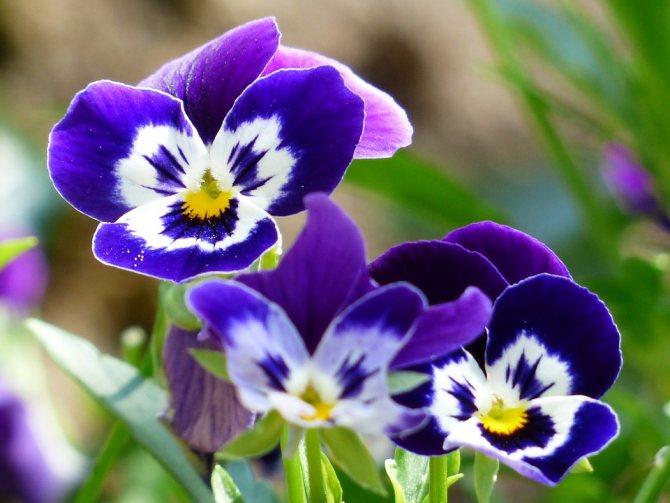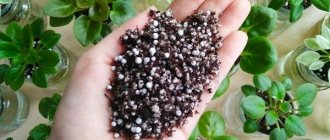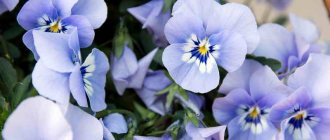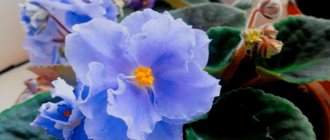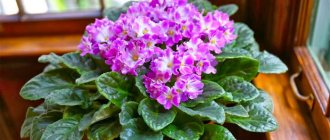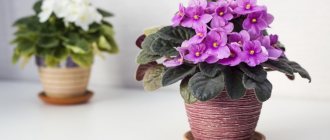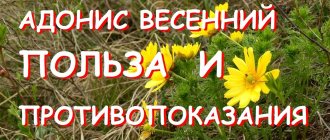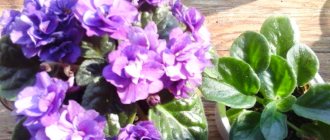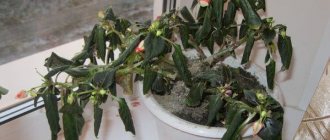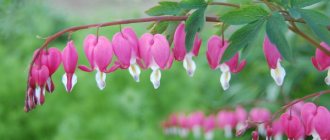Violets are greatly influenced by the conditions in which the plant is grown... This especially affects young specimens.
Low or high temperatures, chemicals or seed age are able to give such mutations that can allow to grow a new beautiful variety or turn a flower into a "gray mouse". When choosing varietal Saintpaulias for home collection, sometimes from the seller you can hear such a definition as violets-sport: what does it mean and how they differ from varietal plants we will explain further in our article.
Flower shape
Pansies (anyutka)
The classic flower shape, in which the two upper petals are smaller than the lower ones.
Star
The flower has five petals of the same shape and size, which resembles a star.
Bell
The petals fused at the base do not allow the flower to fully open, which makes it look like a bell.
Wasp
The lower petals are wide and even, the upper ones are narrow and elongated, slightly curved back. The narrow petals are often curled up at the base. The shape resembles a cyclamen.
Classification of Saintpaulias by outlets
Socket dimensions
The rosettes of adult Saintpaulias are:
- large (diameter from 40 to 60 cm);
- standard - more than 70 cm in diameter;
- half-mini (half-miniature) - about 20 cm in diameter;
- mini (miniature) - up to 15 cm in circumference;
- micromini - violets with rosettes up to 6 cm, although bushes with a diameter of less than 2.5 cm can be found.
The size of the rosette depends not only on belonging to a particular variety, but also on the size of the pot, the composition of the substrate, the humidity of the air and other conditions of the Saintpaulia.
Socket forming type
The most typical of Saintpaulias is the formation rosettes from one point of growth... Sometimes such violets form stepchildren, but this usually happens in conditions of high humidity. Since the stepsons, deforming the bush, negatively affect the decorative effect of the plant, it is advisable to separate and root them.
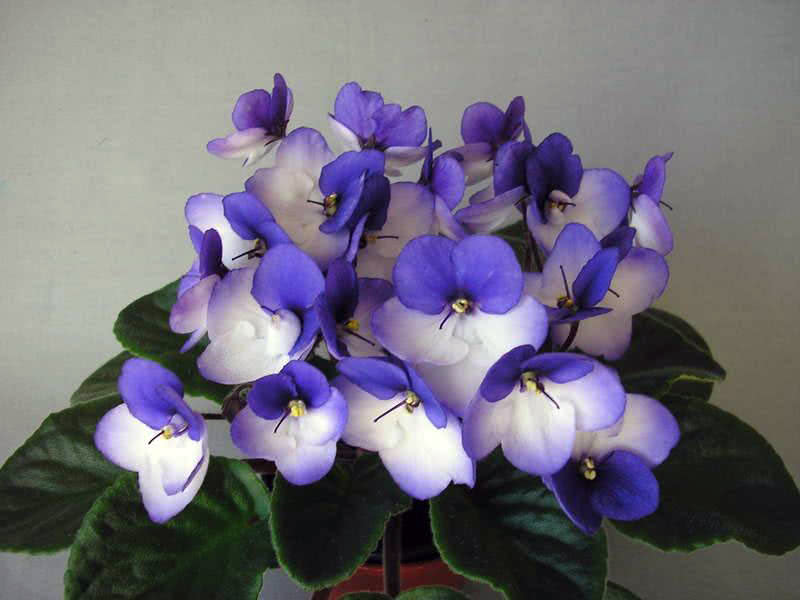
Trailers Are cultivars of Saintpaulia, the stem of which branches out, forming several points of growth. In these plants, the leaves are not as dense as in other varieties of violets. Among the trailers are different:
- bush violets - bushes growing upward or slightly to the side with several points of growth and with predominantly standing flower arrows;
- ampelous - rosettes with long shoots and peduncles hanging down.
Trailers are commonly used for composition and interior design.
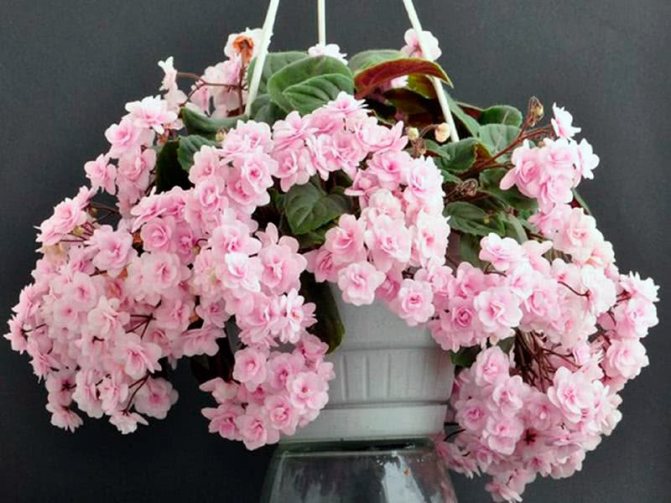

Painting type:
Monochromatic
A flower has only one color.
Two-tone
Two shades of the same color in the form of thickening of color, shadows, rays, etc.
Two-color or multi-color painting
More than one color on the petals. There are the following two-tone color options:
Border
It can be in tone with the petals or in a contrasting color. The width and presence of the border, in addition to varietal characteristics, is influenced by the temperature of the violets: it is believed that in conditions of increased temperature, the border (especially white or green flowers) may completely disappear, but resume with the onset of colder weather. A thin border of a contrasting color is sometimes called "pencil", i.e. as if along the edges of the petals were drawn with a colored pencil.
Solid border
The thin pencil white border is sometimes called the Geneva border after the ‘Lady Geneva’ variety that first introduced it.
Double border
Login to the site
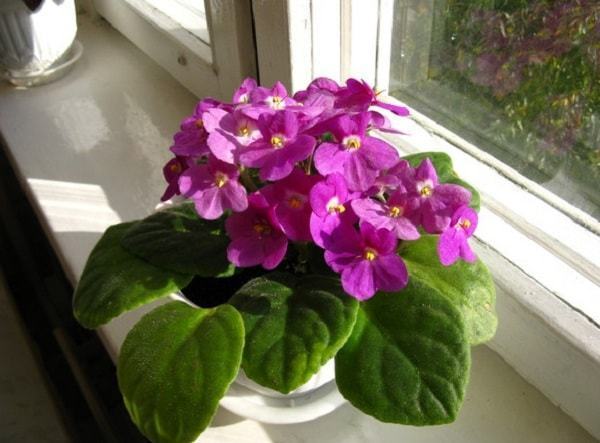

Is your windowsill decorated with a beautiful violet? You can only be congratulated, since this is not just a beautiful flower, but also your home physician and fortuneteller. Violet or Saintpaulia is one of the few indoor plants that subtly feel the spiritual mood that reigned in the house, as well as in the family. Violet has the peculiarity of "getting attached" to one person who talks to her, cherishes, cares for and loves, they can literally become "one whole". Although this plant does not deprive other family members of attention, since if the violet is in the house, the signs associated with the family will be accurate and true.
SIGNS RELATED TO THE VIOLET IN THE HOUSE
If a young violet has released a flower for the first time, then unexpected good news should be expected.
When the violet begins to bloom, you need to count the number of flowers, even means monetary profit, odd, on the contrary, losses. And only after that, the flower can be transplanted.
If you have several multi-colored violets on your window, then you should pay attention to which one will bloom first. White - a romantic date, pale lilac - a joyful meeting, red - great love and passion, purple - an important event, pink - adoration. The violet began to wither, which means that very soon the person who last watered it may get sick. If the flower died, it took upon itself a serious illness of its owner.
If there is a marriageable girl in the house, she needs to be presented with a white violet, you can bloom. They should "get to know" and start communicating. Such a friendship should last for 30 days - it is advisable for a girl to start every morning by greeting the flower, touching the leaves when watering, she should also speak and praise the flower. After a month, you can ask the violet: tell me if the girl will get married. If the violet releases a flower in speed, then the answer is positive, if there are no changes, then negative. If the flowers begin to dry up, it means that it is not yet time for marriage.
Violet can predict a woman her pregnancy, if suddenly a flower of a different shade appears on the violet. It needs to be plucked and eaten. If a guy wants to confess his love, then he must give his beloved a blooming pink violet. It will also become an indicator that the feelings are strong and strong if the plant begins to bloom violently. By the way, before a quarrel of lovers, the violet may become sad, dropping the leaves. It is advisable to put violets in all rooms in order to understand where the best atmosphere is: where they bloom and grow fat, there it is worth making a nursery or a bedroom in order to relax mentally and physically. In the room where violets do not like it, it is advisable not to talk about new beginnings and plans for the future - they will not come true.
Children and animals usually choose their plant. Pay attention to which one they prefer in their apartment and keep an eye on it. If it blooms, then your child also feels fine. If it suddenly withers, then your child or pet is depressed - pay more attention to him.
There is a belief that if the leaves of a violet turn yellow, then its owner may have mental anguish - deception, betrayal, or the illness of a loved one. If the leaves of the violet sank - to tears, they began to rot - a nuisance with slander. True, this sign works if the flower is properly looked after, since the plant can behave in this way, experiencing discomfort due to improper care.
A withered flower cannot be thrown away immediately, violets have a peculiarity to come to life. It is possible that you simply stopped communicating with the plant, and it became sad. Do not forget about your favorite, and she will answer with lush color and thick leaves.
a source
Features of the workpiece for use in traditional medicine
Collecting violets for medical purposes starts in summer... June and July.When plants are actively blooming:
- I cut the violets at a distance just above the ground. 6-9 cm. The stem without leaves is also cut off;
- Well-ventilated areas are suitable for drying. With natural drying;
- Artificial drying is often used. At a temperature not higher than 40 degrees.
Important! At one site, the collection is carried out for medical raw materials for only 2 years.
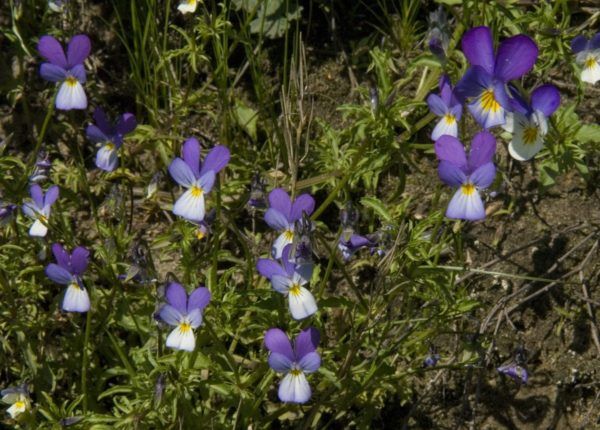

The violet is often used for medicinal purposes.
Sword grass
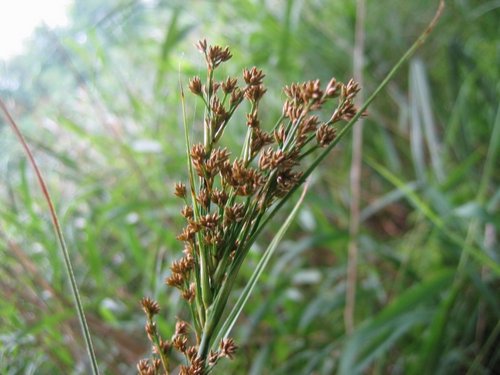

A relict plant growing in the European part of Russia and the Caucasus. It gets its name from the sharp leaves that resemble a sword and have cutting properties. The grass grows along the swampy and muddy banks of the rivers and lakes of the country. The plant stretches up to one and a half meters in height. The inflorescence resembles spikelets, and the seeds are carried by water. There are no exact data on the size of the population. The herb sword is under threat of complete extinction. The negative factors include the economic development of reservoirs, peat extraction and fires. The reservoirs, along the banks of which the sword-grass grows, must be given the status of protected areas.
Habitat
The most common places of germination are considered to be:
p, blockquote 2,0,1,0,0 ->
- Siberia;
- Primorsky Krai;
- Altai Republic;
- Khakassia;
- Buryatia.
This flower does not grow outside of Russia.
p, blockquote 3,0,0,0,0 ->
Like other perennial flowering plants, it can bloom and bear fruit several times throughout its life. It tolerates drought, overheating and dehydration without any problems. In addition, it develops well in such areas:
p, blockquote 4,0,0,0,0 ->
- petrophilic steppes;
- areas close to molehills;
- abandoned trails on meadow steppes;
- slightly sodded river gravel.
The number is currently not estimated with accuracy, but it is believed that the decline in the population is influenced by:
p, blockquote 5,1,0,0,0 ->
- high pasture load;
- sprawl of settlements;
- road building;
- industrial development.
Description
Violet incised in height reaches twenty centimeters. It is stemless, with a vertical rhizome. The name comes from the shape of the leaves of this flower: they are incised, reach a length of up to eight centimeters, ovoid.
The flowers of this relative of Saintpaulia are small - only two centimeters in diameter. The colors are blue, purple, rich, very beautiful. Bracts (narrow lanceolate) are located on the peduncles. Violet-lilac corollas give the plant an inimitable charm.


Reproduction occurs by seeds, but their flower does not create annually, but less often. Therefore, the plant is considered very rare and is protected by the Law (it was listed in the Red Book). The history of this flower is known from Ancient Greece, where it was considered a symbol of Demeter's daughter, Persephone, and was often depicted in frescoes in her hands or a wreath.
Colchis boxwood
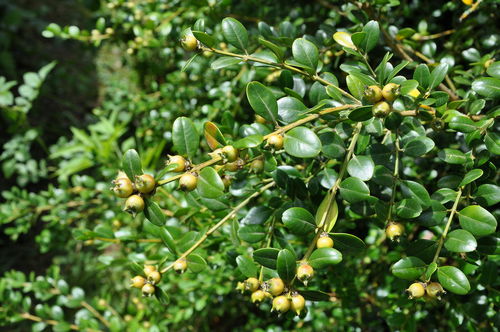

A shrub plant common on the slopes of the Greater Caucasus. Its habitat is humid forests. An abundance of heat, moisture and light plays an important role in the development of boxwood groves. The shrub has small green leaves, the bark is covered with green moss, which acts as a heat insulator. During flowering, yellow flowers bloom on the bushes. The value is represented by durable wood, which even sinks in water under its own weight. Deforestation and export negatively affected the plant population. Only maximum control over the condition of groves and a complete ban on felling will allow this small species to be preserved on the territory of Russia.
Classification of Saintpaulias by flowers
Saintpaulia flower size
Flowers in Saintpaulias can be small (up to 2 cm in diameter), medium (from 3 to 4.5 cm), large (from 4.5 to 6.5 cm) and giant, reaching 10 cm in diameter.However, the visual perception of the size of a flower is influenced by the size of the rosette and leaves: if the rosette is large and the leaves are large, then even a flower of a decent diameter may seem small.
Number of petals in a flower
On this basis, Saintpaulias are divided into:
- simple, the flowers of which consist of four, five or six petals;
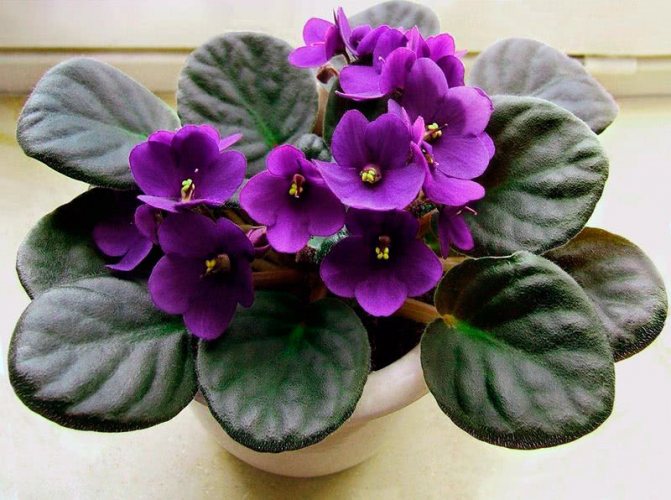

- semi-double (combed), the flowers of which can consist of 5 ordinary petals and several additional small petals concentrated in the center of the flower. Sometimes there may be only 1 or 2 additional petals, and they are almost the same size as the main petals;
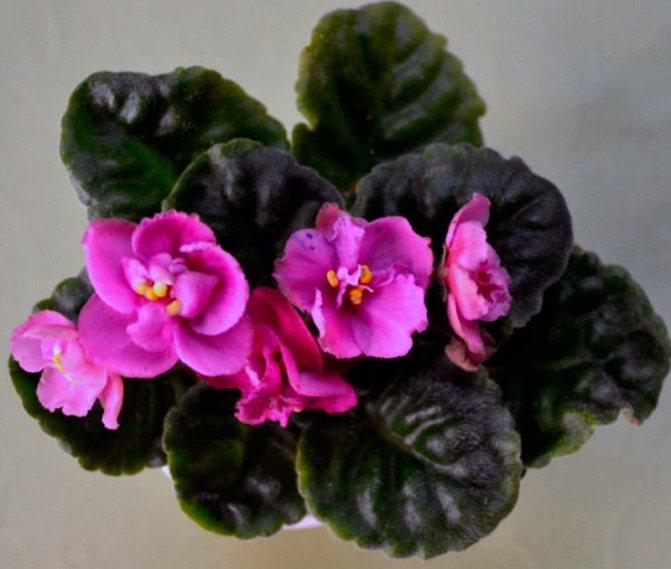

- double, the flowers of which consist of two or more rows of petals: the lower row is represented by large petals, followed by a row of medium-sized petals, and the upper row consists of small petals. Double flowers can be flat, with open anthers, or spherical.
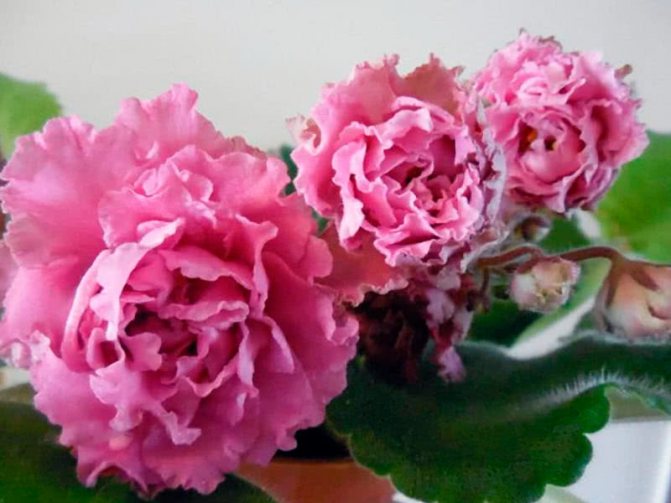

The first terry cultivar was bred in 1939.
Flower shape
The shape of the flowers of Saintpaulia can be:
- violet-shaped (standard, classic, violet): the flower consists of five petals, while the two upper ones are slightly larger than the lower three petals;
- star-shaped, or star-colored: the flower can consist of four, five or six petals of the same size and located symmetrically relative to each other;
- Wasp (Wasp): This category is represented by wasp-shaped five-petalled flowers with narrow petals, but sometimes they look more like a bell or half-bell.
Edge shape and color of Saintpaulia petals
The edge of the violet petals can be even, slightly wavy or strongly corrugated, scalloped or fringed, resembling a frill. The first varieties with fringed petal edges were bred in 1953.
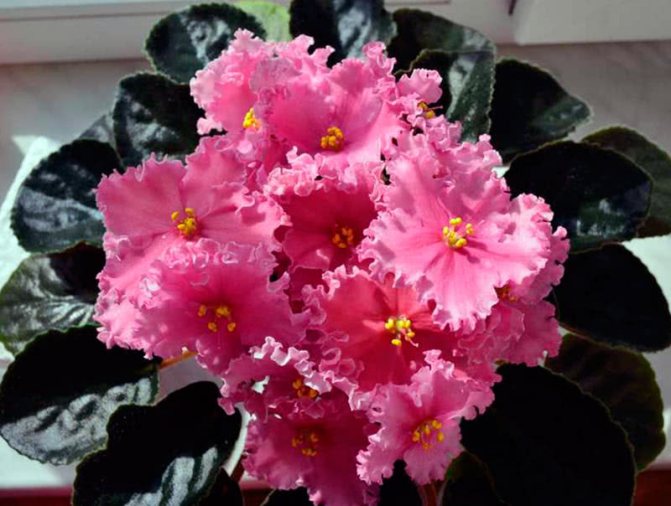

Saintpaulia flowers can be painted in one color, although on the same petal there may be areas with a more intense color - closer to the anthers or, conversely, along the edge.
There are two-color cultivars, and both contrasting colors and shades close in gamut can be combined in one flower.
There are also multicolored violets, the petals of which are painted in different colors.


Saintpaulia petals drawing
The color of the petals of indoor violets can be very different. For example, there are violets:
- fringed, in which a border of a tone different from the main color passes along the edge of the petal. Varieties of the Geneva series with a white border are popular - their colors are the most contrasting. Geneva's first variety was purple-flowered;
- fancy, in which the petals are covered with strokes, splashes, dots and even peas of a color contrasting with the main tone;
- spotted, with the so-called finger pattern, which have a spot of a contrasting color on each petal;
- chimeras - rays of a contrasting color pass along the petals of these violets from the middle to the edge.


There are also green-flowered varieties of violets, but the breeding of saintpaulias with red and yellow flowers is one of the goals of modern breeding science.
Curious facts
- despite the fact that the official discovery of the violet took place at the end of the 19th century, the flower was known in the ancient world;
- Greeks believed that the plant was created by Zeus and left it in the gardens of Olympus. His daughter Persephone discovered the bushes and picked a bouquet. At this moment, the girl was kidnapped by the king of the underworld. While he was carrying the beauty to him, she dropped the bouquet, which ended up on the ground;
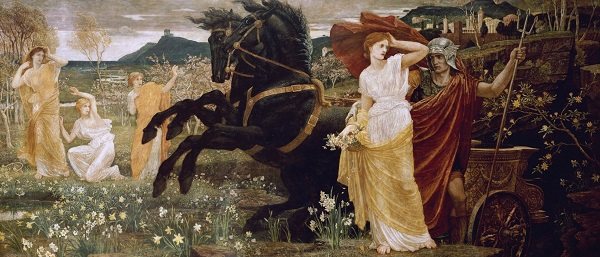

Painting by Walter Crane. "The Abduction of Persephone".
- one more ancient greek legend says that the goddess of beauty Aphrodite was going to swim. At this time, she noticed several young men spying on her. Disgruntled Aphrodite turned to Zeus. Zeus turned the youths into tiny violets;
- scientists came to the conclusion that the Greeks first learned about violets in 500 BC... The inhabitants of Greece considered this plant an aphrodisiac, used it as an ingredient in various dishes and added it to love alcoholic drinks;
- there are now more than 10 thousand different varieties and hybrids of plants;
- at the end of the last century, an unusual space experiment was carried out. The seeds of Saintpaulia have been traveling in space for 6 years. After that, extraordinary profusely flowering violets with a light green fringe of petals grew from the seeds. The series was named Ever;
- these flowers have useful properties... Thanks to the phytoncides that the bushes secrete, the air in the house is purified as much as possible. In such apartments there is a kind atmosphere, since phytoncides have a calming effect on people, improve metabolism, give strength, endurance;
- created in Japan saintpaulia scent dress... The pleasant smell does not disappear even after 5-8 washes;
- made from Saintpaulias one of the most unusual desserts in the world... The name of the delicacy - sugar violets: Flowers are covered with a layer of chicken protein and dipped in powdered sugar.
- then thoroughly dry and put in glass jars.
- sweetness can be consumed as an independent dish or used to decorate dessert compositions.
How does a lack or excess of light affect the growth and development of a plant?
Do the violets need light, they themselves will prompt you with their appearance:
- if the young leaves develop well, and the peduncles rise above the rosette, it means a violet enough light;
- elongated petioles, too thin a leaf blade, the leaves are directed upward, the violet stops growing and blooming - a sign insufficient light;
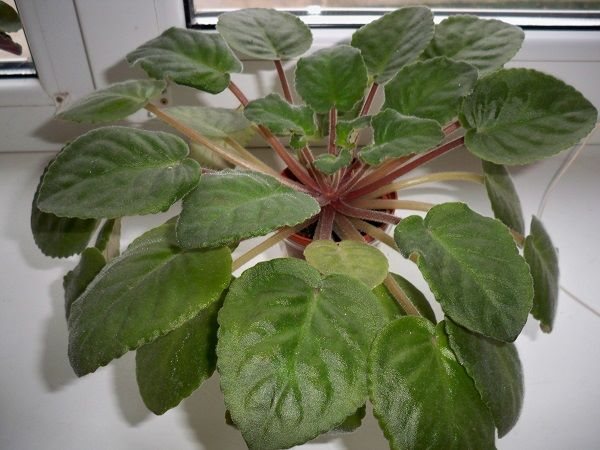

With a lack of light, the leaves begin to stretch.
- in good light leaves of variegated varieties are brightly colored;
- leaves go down, beyond the edges of the container, the color is light, with yellowness, the petioles are shortened, the rosette is thickened - long daylight hours (more than 14 hours);
- short peduncles, pale color and shrinking flowers, short flowering period - excess light.
Cosmetic use
Cosmetologists often use it as:
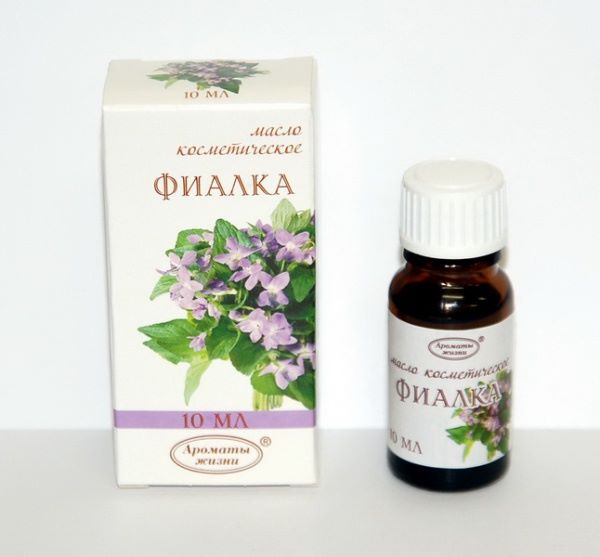

The violet is often used to create cosmetics.
- Eliminate acne;
- Treat abrasions and bruises;
- To eliminate pustular formations;
- Compresses and lotions degrease the skin. That normalizes the sebaceous glands and eliminates itching.
Violet is a healthy herb. The instruction will allow you to use it correctly.
Thin-leaved peony


A perennial plant that grows in the European part of the country. Thin-leaved peony can be found in the steppe zone, on rocky mountain slopes, forest edges and glades. Plant height can reach half a meter. Peony leaves are thin, divided into feathers. Flowering occurs in early May. The color of the flowers ranges from purple to blood red. The diameter of one flower is 8 cm. Terry specimens are rare.
The plant is winter-hardy and drought-resistant, but blooms poorly in shaded areas. Due to the reduction in the area of the steppes, the number of peonies has sharply decreased. Today it can be found only in lands inaccessible for plowing. Another negative factor is grazing, which tramples the aerial part of the plant. Also, the thin-leaved peony suffers from the massive collection and digging of rhizomes. Numerous populations have survived only in the territories of nature reserves.
Distribution area
Where does the Tricolor violet live? Highly common plant worldwide. It is even considered weedy and alien. For many centuries, these flowers have been growing without human participation.
In ancient times she was a symbol of Athens... So it turns out that their homeland is the entire northern hemisphere of Eurasia.
In numerous territories know this flower... Both with a temperate climate and a harsh climate:
- It is more difficult to name places where there are none in Western Europe. Unless you rarely see her on the Mediterranean coast.They are even the floral symbols of the provinces in Sweden;
- And imagine a vast area between two lines: 1st. From Murmansk to Tobolsk. Through Kirovsk, Kandalaksha, Pechora, Vorkuta and Yekaterinburg;
- 2nd. From the Carpathians to Chelyabinsk. Through Chisinau, Odessa, Zaporozhye, Donetsk, Rostov-on-Don, Volgograd, Samara, Orenburg;
- And also the Krasnoyarsk Territory, Altai, the Far East, Crimea.
Important! All these are the places where this violet grows in the territory of the post-Soviet space.
Habitat
Her whole blooming colonies wherever you can meet:
- In the meadows;
- In numerous bushes;
- On glades and forest edges;
- On former pastures;
- In old parks and gardens;
- Near the roads;
- The will of abandoned houses and estates.
We reveal the secret of the popularity of the plant
Saintpaulia has a wide range of perennials and annuals. All of them are a herbaceous plant with a short stem and delicate petals from 4 to 12 pieces, collected in a rosette. Lush flowering, delicate petals with smooth or wavy edges.
The first official appearance of these representatives of the flora dates back to 1893. Then they were presented by the collector of rare plants Ulrich von Saint-Paul. After their debut, the Saintpaulias received publicity, they were written about in thematic magazines.
It is noteworthy that the flower itself was not discovered by Wilrich, but by his son. The younger Saint-Paul noticed an unusual natural creation right in the crevice. The rich blue flowers and the yellow, searing light in the middle delighted the man, and he decided to immediately send a sample to his father.
Since then, the scientific name of the flower has been named after its discoverer - saintpaulia. The homeland is considered to be just the area where the violet was discovered - Tanzania Africa. After the discovery of Saintpaulia, many breeders began to improve it. Their goal was to get larger inflorescences and, of course, diversify the color scheme.
They owe their popularity in the Soviet Union to the eminent breeder Boris Makuni. Together with his wife and sons, he devoted more than 30 years to this business, and as a result, about 80 new unusual species of violets were bred. Each variety has its own name.


Application of Violets Notched
Violet Notched is not used in medicine or cooking. The only area of application is landscape design. A variety of flowers and shrubs come in handy here.
We have written a lot about this application of plants. For example, how the gray spirea of the arguta and grefshame are used to decorate the landscape.
High decorativeness, simple seed reproduction, of course, is a prospect for wider cultivation of this crop. Workers of botanical gardens are doing all they can to preserve the population.
Panax ginseng
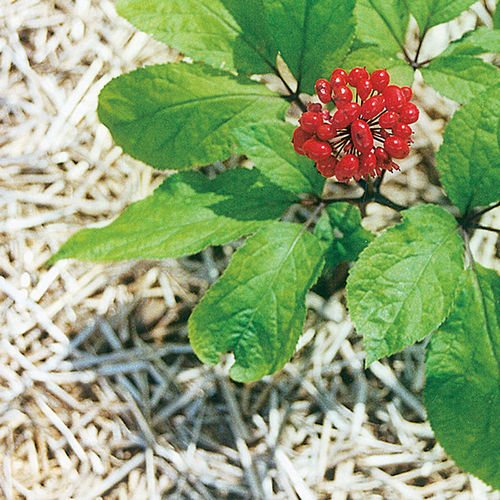

A narrow-area plant that is found in the Primorsky and Khabarovsk regions. Panax ginseng grows in cedar-deciduous forests and on rocky slopes. As a rule, there are single individuals, the plant does not form clusters. In shape, the root of this perennial resembles a human figure. It has a powerful root, a thin stem, and the inflorescence forms an umbrella. The pulp of the fruit is poisonous.
The plant is known as a healing agent. It has general tonic properties. In medicine, ginseng roots are used, which contain essential oils, trace elements, vitamins and peptides. The decline in numbers is directly related to the harvesting of roots. Ginseng also suffers from forest fires. To date, the plant is bred artificially. Plantations are located in the Primorsky Territory.
Classification of saintpaulias by leaves
Saintpaulia leaf color and the presence of a light spot on them
The top of the leaf plate can be painted in all shades of green: from light to dark, almost black, and the underside of the leaves is painted in light green, dark green or purple.Now cultivars with heterogeneously colored leaves have appeared: on the green leaf there are lighter areas of the most different shapes, as if chlorine was splashed on the leaves. Interestingly, with age, these spots can change in size and shape.
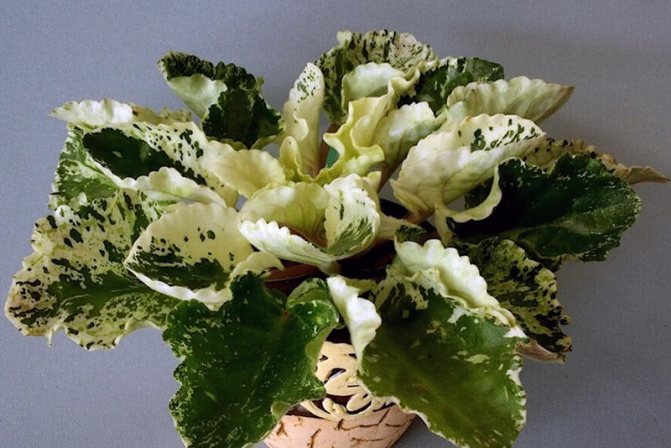

The color of the leaf plate, both above and below, under the influence of external influence and with age, changes, becoming paler or richer.
Such a feature as a light spot at the base of the leaves divides the varieties of Saintpaulia into "girls" (girl) and "boys" (fight). The discolored spot, like the ruffled edges of the leaves, reminiscent of a fluffy girlish hairstyle, is a sign of the less common "girl". There is no spot on the leaves of the "boys".
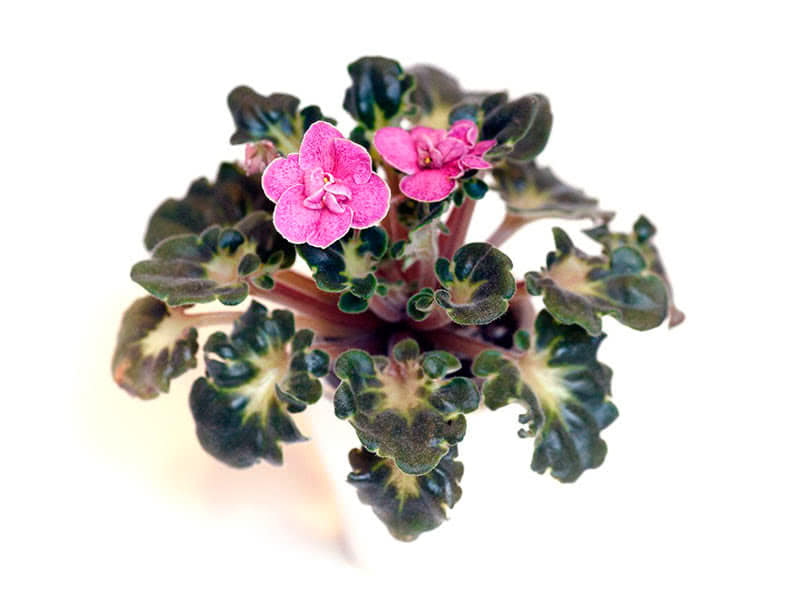

A few tips for caring for indoor violets
Florists agree that these plants are quite finicky and always require maintaining optimal living conditions. Therefore, before buying, you should definitely study the rules for growing violets and purchase all the necessary tools.
Secrets of growing flowering Saintpaulias:
- Pot selection. It should be small and not too deep. For an average flower, a container with dimensions of 7x7 cm is quite suitable.
- The soil. Professional florists advise purchasing ready-made soil, where the optimal ratio of components will be observed. You can also prepare the composition yourself by mixing peat, coconut fiber, perlite and compost for this.
- Shine. Moderate lighting is the key to lush bloom. At the same time, they do not particularly like direct sunlight, optimally - diffused light.
- Air temperature. For the most successful life of Saintpaulia, it is enough to maintain the temperature within the range of 20-22 ° С.
- Water. Do not allow the soil to dry out, but at the same time it is extremely unacceptable for water to get on the leaves. Florists recommend watering through a pallet.
During the active growth and flowering phase, plant conditions should be reviewed by adding additional nutrients to the soil and dosed watering. Florists recommend applying nitrogen, potash and phosphorus fertilizers to the soil. After the transition to the passive phase, reduce the daylight hours to the plant by 1-2 hours, watering only as the soil dries out.
TOP of the most unusual varieties
In addition to the classic purple Saintpaulia, there is just a huge variety of truly unique plants. We offer a selection of varietal beauties that are recognized as the most unusual.
Lituanica
It differs in everything both in the shape of the leaves and in the structure of the flower. Its pale green leaves have a beautiful fluted edging. At the same time, at first glance, if you look at the inflorescences themselves, you can confuse them with the flowers of a wild rose or even a wild rose. As a result, Liutanika is a lush bush with numerous petals, incredibly voluminous and mesmerizing flowers.


Lituanica
The bride's bouquet
Of particular value for flower growers, because this variety of violets is extremely rare. Its main value lies in its snow-white colors. At the same time, the inflorescences are fluffy and consist of many double leaves.


The bride's bouquet
Magenta
This variety was bred by the breeder Lebetskaya. It took a very long time to create it, but the result is worth it. Magenta has a complex petal color. So, the total area is painted in a bright burgundy color, and the edges have a light smoky white edging. The rich yellow center only adds brightness to the bouquet.
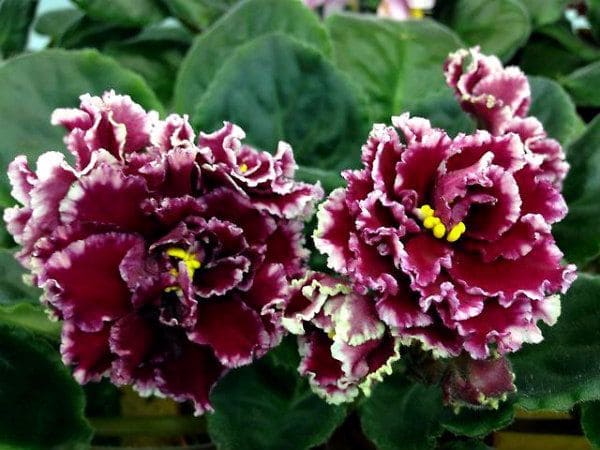

Magenta
Gray ocean
This Saintpaulia attracts with its inconstancy. The thing is that with each new flowering, its leaves change color. Young representatives have inflorescences of a white tone and small blotches of purple or blue. Over time, the white recedes, and the plant begins to bloom only in blue or dark purple.
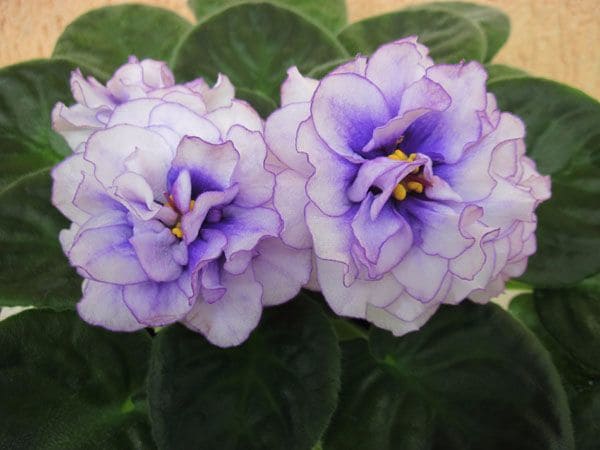

Gray ocean
The land of crimson clouds
The flower itself is no less intricate than its name. Differs in large terracotta-crimson flowers. In this case, the shade tends to darken closer to the base of the inflorescence. Light edging around the petals adds extra lightness. Saintpaulia leaves are not inferior in originality. They are a triple flower combination. The top is dyed in rich green with a creamy canvas, and the back has a pink tint.
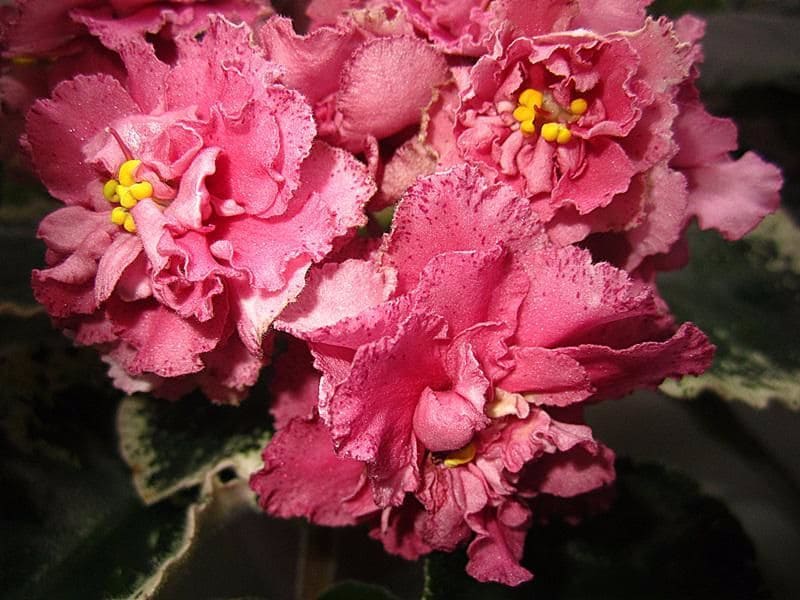

The land of crimson clouds
Lianz Pirates Treasure
A pink violet with a wide crimson border. On closer inspection, you can see that the edges of the petals are strewn with small purple dots. The leaves are dark with pronounced veins of a darker color.


Lianz Pirates Treasure
Rosemary
Another type of pink violet, which attracts with an unusual scattering of dark crimson blotches on the petals. The inflorescence is formed by semi-velvet petals, medium in size.
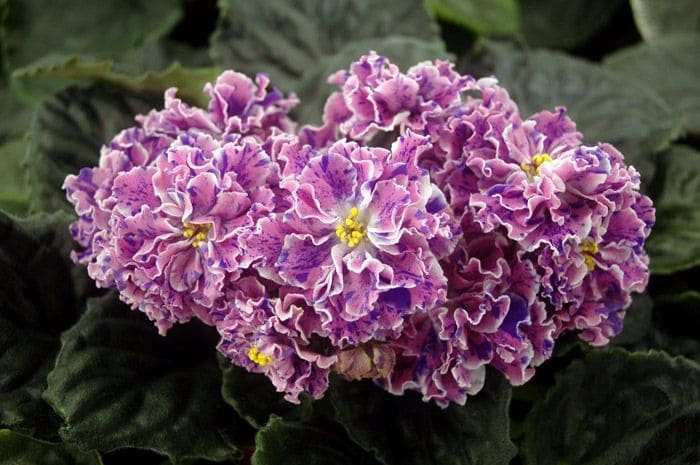

Rosemary
Winter rose
Inflorescence of many medium-sized petals of deep blue color. The flowers are large, have a light border. Small dark leaves complete the rosette. Pleases the owners with exuberant and long flowering.
Having the listed saintpaulia varieties is a special honor for any collector. Well-known breeders have spent a lot of time and effort on the development of each of the varieties. But the result was more than excellent.
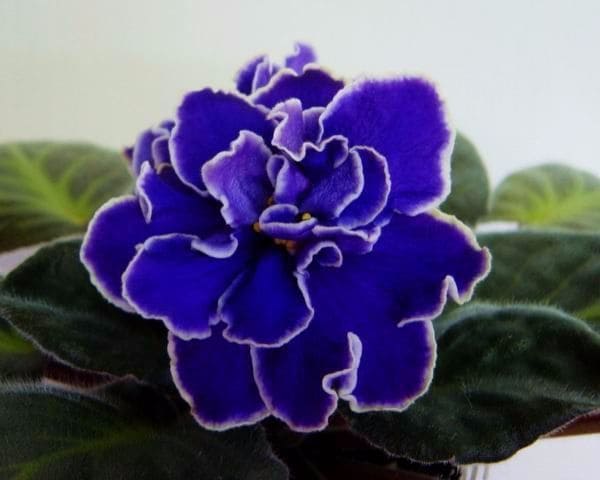

Winter rose
Growing
Even beginners propagate them by seeds without problems. It's convenient and affordable. There would be seeds!
Planting dates for seedlings
Landing dates in full depend on your wishes... When you want to see bloom:
- In the spring... Sow the seeds well in advance. Even in the summer. The month of July is fine. Before the onset of cold weather, the plant will grow leaves and roots. But they won't be able to bloom. Provide them with wintering. So that they bloom in the spring;
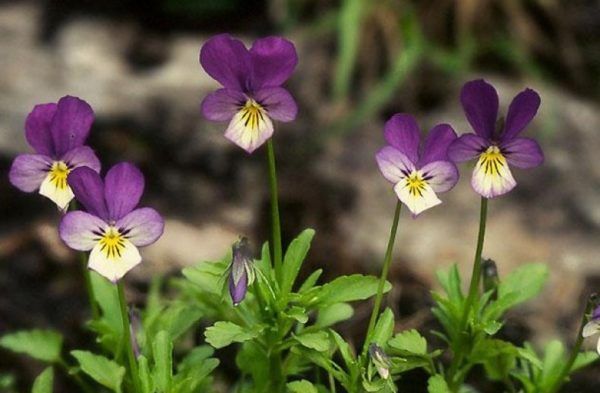

It is best to plant violets in spring. - In summer. In February-March it is necessary to sow: In April, dive them;
- Plant seedlings in the ground in May.
With good care you can see the flowers after 2.5 months.
Important! After blooming in the fall, violets will not be able to winter out.
Technology
Many means are suitable for growing violets by seeds. Including henchmen:
- Boxes and containers for seedlings: Plastic cups;
- Plastic boxes for pastries and cakes;
- With direct seeding, they will not be required.
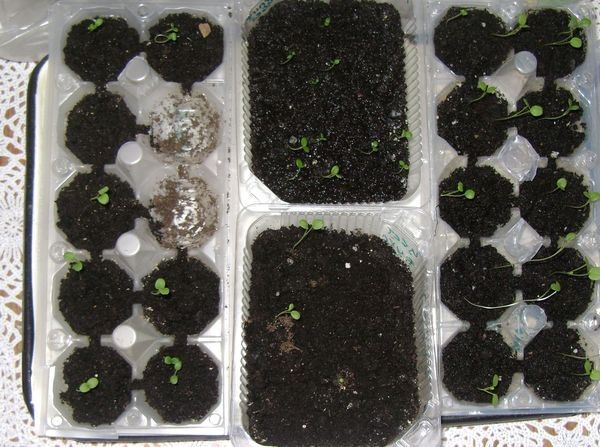

You need to plant seeds in special boxes or containers.
- Plant violet seeds in rows;
- Prepare light soil and fill the container of your choice. Add vermiculite;
Please note! Some varieties of these violets can self-propagate.
Seed stratification
Stratification flower growers make violet seeds for their better germination:
- This is a long-term cooling of seeds in a humid environment. So that the seeds come out of a dormant state faster;
- After sowing seeds in boxes, flower growers put them in the refrigerator for a couple of weeks;
- It can be different. The seeds are soaked and placed in bags in the refrigerator for 3-5 days. After drying, they are sown for germination.
Soil temperature
Soil temperature will depend on the selected sowing time. If you sow directly into the ground:
- In April and May, the soil will just heat up to the right temperature for sowing;
- Experienced flower growers sow them even in winter. Or they can simply tilt the seed box and sprinkle it with earth.
Important! They are sown for seedlings at the end of February.
Germination
Light brown seeds pretty small:
- Their length is about 1.5 mm. And the width is about 1 mm;
- One box can contain up to 3 thousand pieces;
- They are not felt at all by weight. The same 3000 pieces will weigh no more than 1.5 grams;
- Ripen from June. Depending on weather conditions;
- They are suitable for planting only for two years;
- But the best germination is given by freshly harvested.
Depending on the quality and seeds may appear after three days... Or maybe on the tenth day. There are features in some varieties.
Picking
Picking promotes good development a young plant. In thickened crops, they can stretch out, and the roots are rather weak.
They dive in 2-3 weeks. after emergence. And in the presence of two real leaves.
Important! Even two bushes in one container can be placed using plastic spoons and toothpicks.
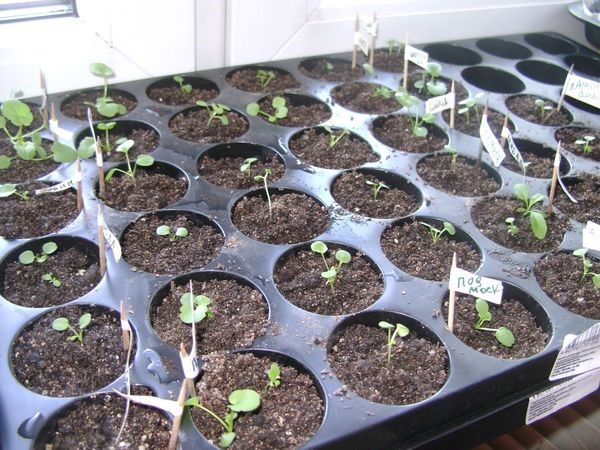

Thanks to the pick, the seedlings grow quickly.
Landing time for a permanent seat
Plant violet seedlings in the ground only when when there will be no frost... Even with buds and blooming violets take root well. With proper care.
Violet pot size.
It is better to use plastic pots for violets. The diameter of the pot is gradually increased with each transplant as the plant grows. It is believed that the diameter of the plant should be three times the diameter of the pot. Do not plant the plant in pots that are too large, since the volume of the soil mixture will not be absorbed by the roots, and this can lead to decay of the root system.
For young plants separated from the mother liquor, pots with a diameter of no more than 5 cm (about 100 ml) are suitable. When the children grow up, pots with a diameter of 7-8 cm can be used for a long time. For adult specimens, pots with a diameter of 9-10 cm are suitable, this is the maximum size limit, the height of the pot should be approximately equal to its diameter. Do not use pots larger than 10 cm in diameter, this will prevent the violet from blooming profusely.
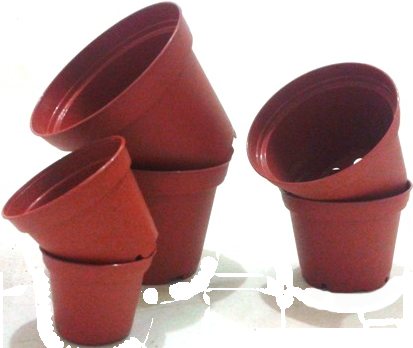

When planting, in no case should the earth be strongly compacted, since dense earth will not be well saturated with water, but after being saturated, it will dry for a long time, the roots will grow slowly and can rot. Just pour soil into the pot, place a rosette in the center, spread the roots and cover with earth on top. Sprinkling earth from above, lightly tap the pot on a flat hard surface - this will slightly compact the soil.
Thus, good care of violets is sufficient lighting, optimal temperature of keeping, proper watering and humidity, high-quality soil and a small pot.
Organization of additional lighting
To properly organize artificial lighting, pots with violets are placed on shelves or racks.
Types of lamps
Conventional incandescent bulbs are not suitable for growing violets:
- they have an unsuitable radiation spectrum;
- low efficiency;
- emit a lot of heat, destructive to the flower.
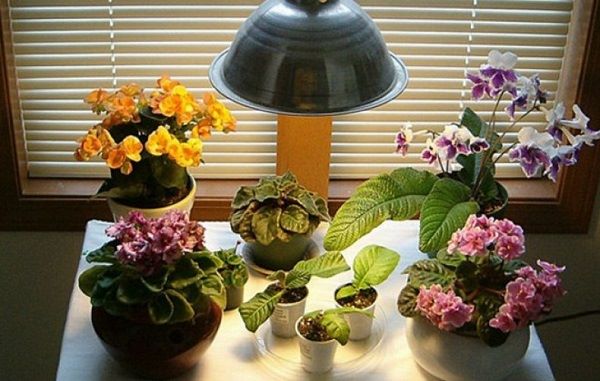

Illumination with incandescent lamps is unacceptable, because they can cause burns.
The light source is usually linear fluorescent lampswhich come in white, cool white and warm white spectrum. They are made in the form of tubes with a diameter of 26 mm and differ in length, which correlates with power:
- a lamp with a length of 60 cm corresponds to a power of 18 W;
- 90 cm long - 30 W;
- 120 cm long - 36 W;
- length 150 cm - 54 W.
The size of the luminaire and its power are selected based on the area of the illuminated place. When choosing a lamp, it must be borne in mind that:
- the shorter the lamp, the less it will last (the service life of an 18 W lamp is about six months, and a 36 W lamp is almost a year). After this period, the luminous flux weakens, although visually it is not noticeable;
- the luminous flux produced by two 18 W lamps is less intense than from one 36 W.
Fluorescent lamps are filled with small amounts of mercury. As long as the lamp is intact, its use is completely safe.
Caution! A broken fluorescent lamp is dangerous to your health, it is disposed of at special collection points.
Are effective and LED strips. Their main advantage over other lamps:
- high energy efficiency;
- ease of attachment to any surface and in any position.
The downside is the rather high cost.
Distance to outlet leaves, maximum number of switching hours per day
Lamps are fixed on shelves along certain rules:
- the spacing between the shelves is determined by the gap from the light source to the leaves of the flower;
- shelves for standard varieties of violets are placed at intervals of 40-50 cm, while the distance of the lamp from the bush should be 30-35 cm;
- for mini-varieties of violets, they maintain an interval between the shelves of 25-30 cm.
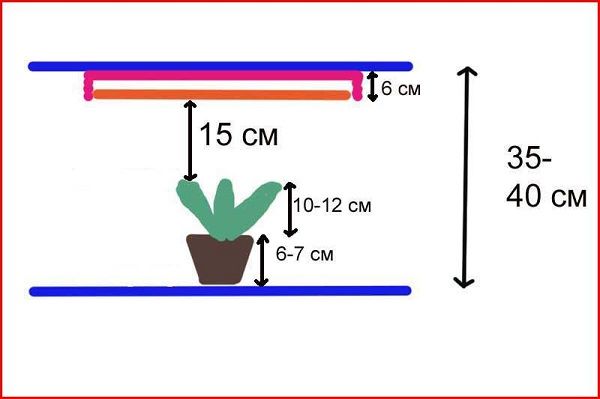

Organization of lighting at standard shelf height.
Wherein you need to take into account the height of the pot and the design of the lamp... For example, with a pot height of 10 - 12 cm and a lamp thickness of 7 cm, the gap between the shelves is about 45 cm.When installing LED strips, the distance between the shelves will turn out to be much less - about 25 cm.
The most comfortable light mode for violets - 12 hours of lighting, 12 hours of darkness... If the plants show that there is not enough light, the lighting period can be increased to 15 hours per day. If this does not help, you will have to change the design of the rack: reduce the gap between the lamp and the flower, or hang another lamp.
Calculation of lamp power
When planning shelves for violets it is worth focusing on the size of a standard lamp:
- for shelves with a length of 70 cm, 18 W lamps are installed;
- for 130 cm shelves - 36 W lamps.
The number of lamps also correlates with shelf width:
- one lamp provides the necessary illumination of a shelf with a width of about 30 cm;
- two lamps - shelves 50 cm wide.
When calculating lighting for violets, it must be borne in mind that:
- light flux per cm2 of shelf area from fluorescent lamps should be 0.7-0.9 Lumen;
- light flux per cm2 of shelf area from LED lamps or tape should be 0.22-0.44 Lumens.
Based on this, a shelf measuring 96x38 cm (area 3650 cm2) must provide a light flow:
- produced fluorescent lamps - 2550-3280 Lumens;
- produced LEDs (lamp or tape) - 800-1600 Lumens.
The optimal light flux is considered, which is closest to the maximum (1300 - 1700 Lumens per shelf). For example, for a shelf of 100x38 cm, the luminous flux should be 840-1680 Lumens.
Advice! The temperature on the upper shelves is always slightly higher than on the lower ones, so it is better to place young plants on them.


